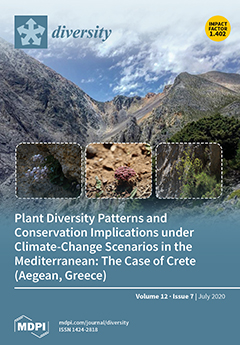Since successful reforestation after the 1970s, Korean red pine (
Pinus densiflora) forests have become the most important coniferous forests in Korea. However, the scarcity of evidence for biodiversity responses hinders understanding of the conservation value of Korean red pine forests. This
[...] Read more.
Since successful reforestation after the 1970s, Korean red pine (
Pinus densiflora) forests have become the most important coniferous forests in Korea. However, the scarcity of evidence for biodiversity responses hinders understanding of the conservation value of Korean red pine forests. This study was conducted to explore the patterns of carabid beetle diversity and assemblage structures between broad-leaved deciduous forests and
P. densiflora forests in the temperate region of central Korea. Carabid beetles were sampled by pitfall trapping from 2013 to 2014. A total of 66 species were identified from 9541 carabid beetles. Species richness in broad-leaved deciduous forests was significantly higher than that in pine forests. In addition, the species composition of carabid beetles in broad-leaved deciduous forests differed from that of
P. densiflora forests. More endemic, brachypterous, forest specialists, and carnivorous species were distributed in broad-leaved deciduous forests than in
P. densiflora forests. Consequently, carabid beetle assemblages in central Korea are distinctively divided by forest type based on ecological and biological traits (e.g., endemisim, habitat types, wing forms, and feeding guilds). However, possible variation of the response of beetle communities to the growth of
P. densiflora forests needs to be considered for forest management based on biodiversity conservation in temperate regions, because conifer plantations in this study are still young, i.e., approximately 30–40-years old.
Full article





